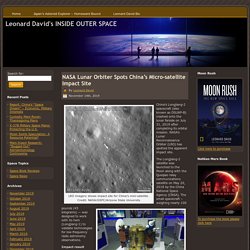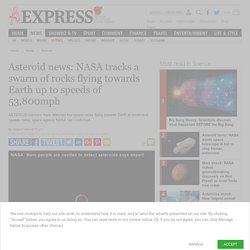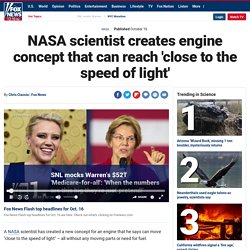

Northrop Grumman launches Cygnus cargo ship to space station for NASA. Northrop Grumman launched a Cygnus spacecraft filled with NASA supplies (and some tasty treats) to the International Space Station Saturday (Feb. 15) in an afternoon liftoff that had some impeccable timing.

An Antares rocket (also built by Northrop Grumman) launched the uncrewed Cygnus NG-13 spacecraft at 3:21 p.m. EST (2043 GMT) — that's "3-2-1" for a liftoff time — from Pad-0A of the Mid-Atlantic Regional Spaceport at NASA's Wallops Flight Facility. "Awesome launch today," Joel Montalbano, NASA's deputy program manager for the International Space Station, said just after launch during live commentary. Related: See amazing launch photos of Antares and Cygnus NG-13! Spaceflight Stories Expected for 2020. The year two thousand and twenty is almost upon us.

And as always, space agencies and aerospace companies all around the world are preparing to spend the coming year accomplishing a long list of missions and developments. Between NASA, the ESA, China, SpaceX, and others, there are enough plans to impress even the most curmudgeonly of space enthusiasts. While it is tough to summarize them all briefly, 2020 is expected to be the year where several major milestones are achieved. These will include the restoration of domestic launch capability to the United States, the deployment of new robotic missions to the Moon and Mars, the rise of the satellite internet market, and more steps taken that will eventually lead back to the Moon and on to Mars. Here’s a rundown of the missions that are sure to be the highlights of 2020 (in alphabetical order): Artemis 1 Known as Artemis 1 – aka. Chang’e-5 Hayabusa2 Returns In November of 2019, Hayabusa2 left orbit around Ryugu and began making its way home.
This new NASA app lets you see what it would be like aboard a manned mission on the SpaceX Crew Dragon. The first manned flight with SpaceX's Crew Dragon capsule, which aims to allow astronauts to travel between Earth and the International Space Station (ISS), is set to take place in early 2020.In the meantime, NASA has publicly released an app, "Rocket Science: Ride to Station.

"The app lets users experience a takeoff aboard a vessel like SpaceX's Crew Dragon or Boeing's CST-100 Starliner.We tested the app to see how a manned flight aboard SpaceX's Crew Dragon would look.Visit Business Insider's homepage for more stories. The first manned flight with SpaceX's Crew Dragon capsule, which aims to allow astronauts to travel between Earth and the International Space Station (ISS), is set to take place in early 2020. If all goes smoothly, it could even take place in the first quarter of the year, according to comments made by NASA administrator, Jim Bridenstine, in a Reuters report. As well as iOS, the game is also available on desktop. NASA Lunar Orbiter Spots China’s Micro-satellite Impact Site. LRO imagery shows impact site for China’s mini-satellite.Credit: NASA/GSFC/Arizona State University China’s Longjiang-2 spacecraft (also known as DSLWP-B) crashed onto the lunar farside on July 31, 2019 after completing its orbital mission.

NASA’s Lunar Reconnaissance Orbiter (LRO) has spotted the apparent impact site. China’s micro lunar orbiter — Longjiang-2 (also known as DSLWP-B).Credit: Harbin Institute of Technology. NASA report finds Boeing seat prices are 60% higher than SpaceX. New NASA study finds long-haul danger for astronauts: Blood flow in reverse. Spaceflight can halt and even reverse blood flow in astronauts' upper bodies, a NASA report said Wednesday, a startling discovery that has important implications for future trips to Mars and other long-duration missions.

NASA has known for decades that spaceflight is rough on the body, and that spending lengthy periods of time in orbit, unburdened by gravity, can cause astronauts’ muscles to lose mass and their bones to become more brittle. Now, in the unexpected discovery, researchers have found that spending time in space can affect how blood flows through a major blood vessel in the upper body, causing it to halt or even flow backwards — a health risk that was unknown until now. In the study, published Wednesday in JAMA Network Open, a medical journal published by the American Medical Association, researchers examined 11 healthy astronauts who had stayed aboard the International Space Station for an average of six months. “It’s potentially a serious problem,” said Dr. A medical mystery. Elon Musk: NASA Can Share SpaceX's IP With Anybody It Wants.
Asteroid news: NASA tracks a swarm of rocks flying towards Earth up to speeds of 53,800mph. NASA: More people are needed to detect asteroids says expert The five asteroids are hurtling past Earth at various times today (Friday, October 18).

NASA said the space rocks are all locked-in on “Earth close approach” trajectories. One of the asteroids will swing by at speeds of nearly 53,800mph (86,580kph). What do we know about the five asteroids heading past Earth? NASA has dubbed all five asteroids Near-Earth Objects or NEOs. NEOs are all asteroids and comets flying around the inner rings of the solar system. These rocky bodies orbit the Sun from distances that bring then close to Earth. Occasionally, NEOs will cross paths with Earth’s orbit and strike the planet. READ MORE: Asteroid warning - Only thing left to do is 'hand out a lot of Bibles' Interstellar space even weirder than expected, NASA's Voyager 2 reveals. In the blackness of space billions of miles from home, NASA’s Voyager 2 marked a milestone of exploration, becoming just the second spacecraft ever to enter interstellar space in November 2018.

Now, a day before the anniversary of that celestial exit, scientists have revealed what Voyager 2 saw as it crossed the threshold—and it’s giving humans new insight into some of the big mysteries of our solar system. NASA TV: Cygnus Space Freighter Arrival at International Space Station. Humans can land on Mars by 2035, NASA chief says. NASA chief Jim Bridenstine has doubled down on his claim that the space agency will be able to land humans on Mars in the 2030s, going so far as to say it could even be done by the middle of that decade.

"If we are accelerating the moon landing, we are accelerating the Mars landing," Bridenstine, NASA's Administrator, said during a panel discussion at the International Astronautical Congress, according to Space.com. "I suggest we can do it by 2035," he added. NASA scientist creates engine concept that can reach 'close to the speed of light' A NASA scientist has created a new concept for an engine that he says can move "close to the speed of light" – all without any moving parts or need for fuel.

The paper, written by David Burns from NASA's Marshall Space Flight Center, discusses a "helical engine" that can be used to travel across interstellar distances, send astronauts to the moon in approximately one second and Mars in less than 13 minutes, according to The Sun, which first reported the news. "A new concept for in-space propulsion is proposed in which propellant is not ejected from the engine, but instead is captured to create a nearly infinite specific impulse," Burns wrote in the paper's abstract. NASA scientist creates engine concept that can reach 'close to the speed of light'
Robotic spiders to explore the moon. There is no doubt that one of the hallmarks of the modern space age is that it is becoming increasingly democratic.

In addition to more space agencies entering the fray, private aerospace companies are contributing like never before. It is no surprise, then, that there are innovators and entrepreneurs that want to increase public access and participation in space exploration. This is what U.K. startup Spacebit and its founder, Pavlo Tanasyuk, hope to accomplish with their decentralized aerospace company. For The Last Time, No, A NASA Engineer Has Not Broken Physics With An Impossible Engine. Mark Rademaker for NASA Eagleworks For centuries, ever since we realized that every star we can see in the night sky is a Sun just like our own — with possibly its own solar system, planets, and possibly even life — humanity has dreamed of crossing the astronomical distances separating us from the ultimate alien destinations. Even the nearest star is more than four light-years away, while the fastest speed a human-created spacecraft has ever traveled at, reached by NASA's Juno mission, is a mere 74 km/sec (46 mi/sec).
Even at that speed, it would take more than 4,000 years to reach the nearest star. There are two limiting factors: the current limits of our technology and the laws of physics. Advances in fields like laser sails, nuclear (instead of chemical) propulsion, or producing and controlling either antimatter or dark matter could provide a game-changing technological breakthrough, but appear to lie far off in the distant future.
Maharishi University of Management Fermilab Fermilab. NASA Spots InSight Mars Lander and Curiosity Rover from Space (Photos) New photos give us the best-ever look at NASA's InSight lander on the surface of Mars and show the route the agency's Curiosity rover is taking up a big Red Planet mountain. The imagery comes courtesy of the HiRISE camera aboard NASA's Mars Reconnaissance Orbiter (MRO), which has been circling the Red Planet since March 2006. HiRISE has been studying Elysium Planitia — the equatorial site where InSight touched down in November 2018 — in an attempt to document changes in the landscape, such as dust devil trails, NASA officials said.
And the camera managed to capture a great view of InSight during such work last month. NASA Engineer Has A Great Idea for a High-Speed Spacedrive. Too Bad it Violates the Laws of Physics. When a NASA engineer announces a new and revolutionary engine that could take us to the stars, it’s easy to get excited. But the demons are in the details, and when you look at the actual article things look far less promising. To begin with, the article is an outline of an idea, not peer-reviewed work.
NASA picture of the day: Cassini satellite captures 5 of Saturn’s moons. On July 29, 2011 the NASA and European Space Agency (ESA) Cassini spacecraft’s narrow-angle camera took this snapshot, capturing five of Saturn’s moons, from just above the ringplane. The moons on the left hand side are Saturn’s small moons Janus and Pandora, which are respectively 111 miles and 50 miles (179 and 81km) across. 403 Forbidden.